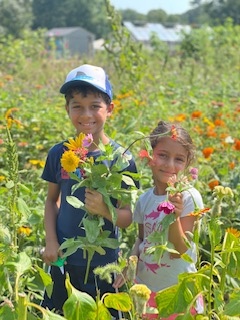Spring Into Science: 5 Easy Experiments for Kids to Enjoy at Home
As the weather warms up and flowers start to bloom, it’s the perfect time to engage curious young minds with exciting science experiments inspired by the wonders of Mother Nature. Whether you’re looking for a quality time activity for the weekend or an educational project to do after school, these simple experiments are sure to delight both kids and parents alike. Best of all, you can conduct them using basic household items, making them accessible and affordable for everyone. So, gather your budding scientist and explore the world of spring-themed science with the following experiments.
DIY Bird Feeder
(Ideal For: 2 to 6-year-olds)
Supplies:
- Large pine cones
- Peanut butter
- Birdseed
- Yarn
Bring feathered friends flocking to your backyard with this fun and functional experiment. Using items like pinecones, peanut butter, and birdseed, create homemade bird feeders that are sure to attract a variety of birds to your garden. Simply spread peanut butter onto the pinecone and then roll it in birdseed until fully coated. Attach the bird feeder to a trees or outdoor hook using a piece of yarn and wait for the birds to flock and feast. This experiment not only provides kids with a hands-on activity but also teaches them about the importance of caring for wildlife and the environment. Have your child keep an observation journal, drawing and learning about the different species that come to the feeder.
Rain Cloud in a Jar
(Ideal For: 3 to 5-year-olds)
Supplies:
- Large, clear jar (3/4 filled with water)
- Shaving cream
- Blue food coloring
- Liquid dropper or pipette
Witness the mesmerizing wonder of precipitation right in your own home. Have your child fluff up the shaving cream on top of the water to resemble clouds. Then, using a dropper, add a few drops of blue food coloring onto the “clouds.” Watch in awe as the color slowly seeps through the clouds and rains down into the water below, simulating a rainstorm. You can also try a similar experiment using a strainer and cotton balls instead of shaving cream for fine motor skills practice. These experiments are visually striking and also teach kids about the water cycle in a hands-on way.
Seed Germination
(Ideal For: 3 to 7-year-olds)
Supplies:
- Styrofoam Cups or Small Pots
- Potting Soil
- Sunflower Seeds
- Bean Seeds
- Radish Seeds
Get your hands dirty and explore the magic of plant growth with this hands-on experiment. Grab some small pots or cups, potting soil, and a variety of seeds such as sunflowers, beans, or radishes. Have your child plant the seeds in the soil, making sure to water them regularly and place them in a sunny spot. Then, sit back and watch as the seeds sprout and grow into beautiful plants right before your eyes. Observe: Which grows fastest or slowest? How deep should we plant the seeds? Which needs the most water or sun? This experiment not only teaches kids about the life cycle of plants, while instilling a sense of responsibility as they care for their growing seedlings.
Bouncy Egg
(Ideal For: 7 to 10-year-olds)
Supplies:
- 1 Large Egg, Cooked or Raw
- A Tall Glass
- White Vinegar
Measuring six-inches in diameter, an ostrich egg is the world’s largest cell. You don’t need an ostrich to astound your child with an egg’s unique properties: a basic chicken egg will do. By submerging the egg in white vinegar overnight, the calcium carbonate shell dissolves, leaving behind a rubbery substance. Over the course of six days, the egg undergoes a peculiar transformation, losing its shell and gaining a unique texture. This change occurs due to the reaction between the acetic acid in the vinegar and the calcium carbonate in the eggshell, producing carbon dioxide bubbles. The result is a shell-less egg with a semi-permeable membrane, capable of bouncing and bending without breaking. By experimenting with different variables such as egg types, vinegar types, and soaking durations, children can explore the nuances of this chemical reaction and discover its endless possibilities. This experiment sparks curiosity and inquiry into the marvels of science.
Butterfly Life Cycle
(Ideal For: 8 to 12-year-olds)
Supplies:
- A Butterfly Garden Kit with Live Caterpillars
Alternative Supplies:
- Large Cardboard Box with Lid
- Tissue Paper
- Pipe Cleaners (for chrysalis building)
- Scissors, Pencil, and Tape
- Clear Cling Wrap
- Twigs, Branches, Flowers
- Sugar Water and Sliced Fruit (food)
- Small Metal Jar Lid or Plastic Lid — Filled with Water (hydration)
Transform your home into an enchanting butterfly sanctuary and view the mystery of metamorphosis. To begin, you have the option of purchasing a butterfly kit online for convenience, or crafting a DIY habitat from a simple cardboard box. Line the interior with tissue paper and add natural elements to evoke a cozy atmosphere. Create a viewing window by carefully cutting a rectangle into one side of the box and securing see-through cling wrap with tape. Remember to ensure proper ventilation by puncturing small holes in the box. If you opt for the hands-on approach, you can venture into your garden or local park to collect caterpillars or butterfly larvae. Over the following weeks, observe with wonder as the caterpillars undergo the extraordinary process of metamorphosis, transforming into delicate chrysalises before emerging as breathtaking butterflies. This immersive experience offers children a firsthand glimpse into the awe-inspiring journey of the butterfly life cycle, fostering a deeper appreciation for the wonders of nature.
With these spring-themed science experiments, parents and kids can enjoy hours of educational fun right in the comfort of their own home. So, roll up your sleeves, put on your scientist hats, and let the exploration begin!



